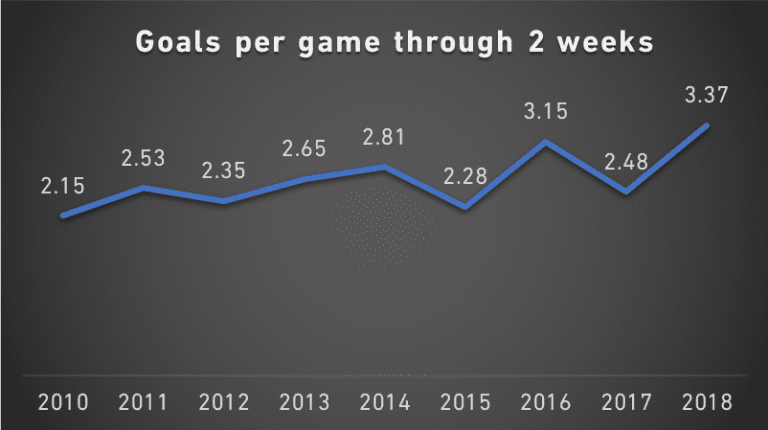Every year we wait three long months for MLS to return to the field. And, for the most part, we continue to wait for the play on the field to match our lofty expectations of what an exciting soccer match should look like.
This was best exemplified last season, when we saw four 0-0 draws over the first two weeks of the season. There was the truce at Toyota, reprieve at RFK and the respite at the RioT. A quarter of the 52 goals scored over those two weeks could be directly attributed to matches involving a Minnesota United squad that were really trying to figure things out (pour one out for Vadim Demidov).
Of course, like most MLS seasons, the lack of goals didn't last: Though just 2.48 goals were scored per game in 2017's first 21 matches, the final number for the year was 2.97 – the highest average since 2002.
Two weeks into the 2018 MLS season, goalscoring has not been an issue. In the 19 matches so far, teams have averaged 3.37 goals scored. That's the highest mark through two weeks of any MLS season this decade.

On Saturday alone, we saw a seven-goal thriller at Toyota Park and the 5-1 domination of Real Salt Lake by LAFC.
The high goals per game figure pairs with the highest passing accuracy percentage we've seen since 2010 (the first year for which we have Opta data), and the second-highest passes per game mark. You will notice an expected goals per game column in the table below. It reveals that MLS teams have actually been a little unlucky thus far, and should have scored more goals, based on their quality of chances. On average, teams would have been expected to score 3.53 goals per game rather than the 3.37 they've put away.
Year |
Passing Accuracy |
Passes/Game |
xG/Game |
|---|---|---|---|
2010 |
74.69% |
766.08 |
N/A |
2011 |
75.97% |
756.58 |
N/A |
2012 |
76.86% |
844.71 |
N/A |
2013 |
75.83% |
792.94 |
N/A |
2014 |
75.98% |
774.38 |
N/A |
2015 |
76.71% |
817.22 |
2.36 |
2016 |
76.50% |
814.40 |
2.95 |
2017 |
76.66% |
867.48 |
2.31 |
2018 |
78.91% |
864.32 |
3.53 |
We're seeing something we don't see very often: open, attacking soccer … in March.
Identifying a singular reason why is difficult this early in the season, given the improved talent and depth in MLS squads (thanks to Targeted Allocation Money), increased tactical nuance from coaches or even teams simply realizing that trying to win games, instead of settling for draws, gives them a greater chance of moving up the standings. Points won in March count as much toward the playoff race as points won in September and October.
The good news is that we are unlikely to see a significant downtick over the course of the season. Only twice since 2010 has the amount of goals per game declined after the first two weeks. One, notably, is the 2016 season, when teams scored 3.15 goals in the first two weeks, but finished the year averaging 2.81.
What we'll see going forward remains, obviously, up in the air. In the video above, Bobby Warshaw gives you a pretty good idea of why he expects a downturn; he might be right. But in the meantime, let's just enjoy the number (and quality!) of goals scored so far.









